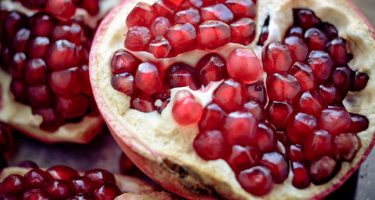Pomegranate - WDRA
Pomegranate
Commodity Code - 190
Commodity Name - Pomegranate
Commodity Scientific Name - Punica granatum

Bhagava, Ganesh, Arakta, Mrudula, Muskat, Jyoti, Ruby, Dholka,PHULE ARAKTA (NO.11/3)
| Grade designations | Grade requirements | Grade tolerances |
| 1 | 2 | 3 |
| Extra class | Pomegranates must be of superior quality. They must have the shape, development and colouring that are typical of the variety and/or commercial type. They must be free of defects, with the exception of very slight superficial defects, provided these do not affect the general appearance of the produce, the quality, the keeping quality and presentation in the package. | 5% by number or weight of pomegranate not satisfying the requirements for the grade, but meeting those of Class I grade or exceptionally coming within the tolerances of that grade. |
| Class I | Pomegranates must be of good quality. They must be characteristics of the variety and/or commercial type. The following slight defects provided these do not affect the general appearance of the produce, the quality, the keeping quality and presentation in the package.
| 10% by number or weight of Pomegranate not satisfying the requirements of the grade, but meeting those of Class II or, exceptionally coming within the tolerances of that grade. |
| Class II | This grade includes Pomegranates which do not quality for inclusion in the higher grades, but satisfy the minimum requirements. Following defects may be there provided the Pomegranates retain their essential characteristics as regards the quality, the keeping quality and presentation.
| 10% by number or weight of Pomegranates not satisfying the requirements of the grade, but meeting the minimum requirements. |
Other Requirements
Pomegranates must be carefully picked and have reached an appropriate degree of development and ripeness in accordance with criteria proper to the variety and/or commercial type and to the area in which they are grown. The development and condition of the Pomegranate must be such as to enable them;
-
to withstand transport and handling, and
-
to arrive in satisfactory condition at the place of destination.
Provisions Concerning Sizing
Size is determined by the weight or maximum diameter of the equatorial section of the fruit, in accordance with the following table:
| Size code | Weight in grams (minimum) | Diamater in mm. (minimum) |
| A | 400 | 90 |
| B | 350 | 80 |
| C | 300 | 70 |
| D | 250 | 60 |
| E | 200 | 50 |
Size tolerance
-
For all grades, 10% by number or weight of pomegranate corresponding to the size immediately above and/or below than indicated on the package.y
-
The maximum size range of 8 mm. between fruit in each package is permitted.
General Characteristics
-
Pomegranates shall be
-
fresh in appearance
-
mature and solid in feel
-
clean, free from any visible foreign matter
-
free from pests affecting the general appearance of the produce
-
free of damage caused by pests
-
free of cracking of skin, mechanical injury/rubbing, staining
-
free of abnormal external moisture excluding condensation following removal from cold storage;
-
free of any foreign smell or taste
-
free of any pronounced blemishes
-
-
Pomegranates should not be affected by rotting or deterioration such as to make it unfit for consumption.
-
Pomegranates shall comply with the residue levels of heavy metals, pesticides and other food safety parameters as laid down by the Codex Alimentarius Commission for exports.
Pomegranate shall be
-
Intact, firm, clean, firmly attached to the stalk of reasonably uniform size, color characteristics to the variety
-
Free from, visible foreign matter, abnormal external moisture, foreign smell.
| S.no. | Tradable parameters | Range-1 | Range-2 | Range-3 |
| A | Essential | |||
| i | Size (mm) | Upto 90 mm | Upto 75 | Upto 65 |
| ii | Defects:- (% by count) Max Slight bruising (2-5sq. cm. of total surface area) | 2% | 5% | 10% |
| iii | Extraneous matter(% by Weight) Max | 95% | 90% | 85% |
| B | Optional (Industrial/Processors) | |||
| i | Weight in Grams (minimum) | More than 300 | More than 200 | Less than 200 |
Sampling
-
5 % or minimum one container shall be randomly selected for sampling
-
5 Nos shall be drawn from each selected container and shall be mixed homogenously , called as primary sample
-
5 nos. shall be drawn from primary sample called as Laboratory sample
Optional parameters are voluntary and may be analyzed as per buyer-seller agreement.
Total Shelf Life - 2 Months
Initial Validity of e NWR - 1 Months
Extension of e NWR Validity - 0.5 Months
Number of Extensions - 2*0.5 Months
Weight Tolerance - Loss or gain equivalent to 70% of the decrease or increase in the moisture content during storage







